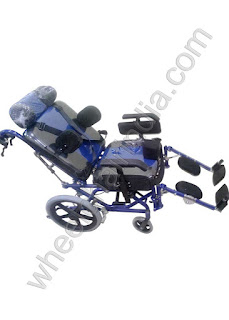Power wheel chair is one type of wheel chairs which is also referred and known as Electric Power Wheel Chair or (EPW). An Power wheel chair is used to move such wheel chairs instead of pushing by some attendant or by hand rims. It also has navigational controls so that it can be moved to any desired direction. Powered Wheelchairs are suitable for those, who are weaker to move the manual wheel chair using the hand rims and also provides its users a level of comfort. The user can control its speed and direction by a joystick sort of control while sitting on the chair. There are many different types of Power wheel chair and finding the appropriate one will depend on each individual’s medical condition.
Karma KP 10.3 Power Wheelchair:
Benefits Of Power wheel chair:
CP has trouble controlling the muscles of the body. Normally, the brain tells the rest of the body exactly what to do and when to do it. But because CP affects the brain, depending on what part of the brain is affected, it might not be able to walk, talk, eat, or play the way most people do. CP can have a mild case or a more severe case it really depends on how much of the brain is affected and which parts of the body that section of the brain controls. If both arms and both legs are affected, a kid might need to use a wheelchair. If only the legs are affected, a kid might walk in an unsteady way or have to wear braces or use crutches. If the part of the brain that controls speech is affected, a kid with Wheelchair Pediatric might have trouble talking clearly.
Cerebral Palsy Wheelchair:
Cerebral Palsy Wheelchair Description:
Cerebral Palsy Wheelchair Recline system:
Recline system provides kids with the most comfortable resting environment.
It also allows stretching abdominal muscle that reduces the stress and discomfort developed after long sitting on the wheelchair.
some characteristics of cerebral palsy:
 |
| Karma KP 10.3 Power Wheelchair Net Price:Rs93590 |
Karma KP 10.3 Power Wheelchair:
- Ergonomic seat system provides comfortable seating
- Tool-free disassembled into 3 parts for traveling and transportation
- Quick-release battery pack
- Washable upholstery
- Height adjustable and flip back armrest
- 2-level adjustable back angle
Benefits Of Power wheel chair:
- Breaks down into 4 components.
- Removable, height adjustable.
- Right or left handside mount.
- Entirely detachable arm-rests enable the user to transfer safely & easily. Also, the elevating and swing-away footrests allow users to adjust to the most comfortable position according to their individual requirements.
- Ultra-lightweight aircraft-grade aluminum alloy frame.
- Bio-technology: paint coating uses special anti-Bacterial materials.
- Detachable armrests and elevating footrests.
- Foldable frame with anti-tippers.
- Detachable and height-adjustable headrest.
- Backrest reclines sm from.
- Detachable and height-adjustable headrest.
CP has trouble controlling the muscles of the body. Normally, the brain tells the rest of the body exactly what to do and when to do it. But because CP affects the brain, depending on what part of the brain is affected, it might not be able to walk, talk, eat, or play the way most people do. CP can have a mild case or a more severe case it really depends on how much of the brain is affected and which parts of the body that section of the brain controls. If both arms and both legs are affected, a kid might need to use a wheelchair. If only the legs are affected, a kid might walk in an unsteady way or have to wear braces or use crutches. If the part of the brain that controls speech is affected, a kid with Wheelchair Pediatric might have trouble talking clearly.
 |
| Cerebral Palsy Wheelchair Net Price:Rs18988 |
Cerebral Palsy Wheelchair:
Cerebral Palsy Wheelchair Description:
- The model designed for cerebral palsy child only.
- Ultra light weight aluminium alloy frame
- Seat Width 38 cms (15")
- Net Weight: 18.5 kgs
- Epoxy powder coated frame
- Detachable arm rest & foot rest provided
- Elevated and swinging foot rest
- Elevated foot rest provided to elevate leg angle
- Height adjustable and detachable head rest
- Hydraulic reclining high back for a comfortable posture
- Hydraulic adjustable seat angle
- Detachable back and seat pad
- Extra cushion upholstery provided to under arm, head & calg
- Foldable
- Lever and paddle brakes provided
- Safety belt provided
- Maintenance free rear solid wheels
- Cloth look like water proof upholstery
- Anti wheels for better safety and stability
- Extra cushion upholstery provided to under arm, head & leg
- Folding action
- Lever and paddle brakes provided
- Safety belt provided
- Maintenance free rear solid wheels
Cerebral Palsy Wheelchair Recline system:
Recline system provides kids with the most comfortable resting environment.
It also allows stretching abdominal muscle that reduces the stress and discomfort developed after long sitting on the wheelchair.
some characteristics of cerebral palsy:
- Lack of muscle coordination when performing voluntary movements (ataxia).
- Stiff muscles and exaggerated reflexes (spasticity).
- Asymmetrical walking gait with one foot or leg dragging.
- Variations in muscle tone from too stiff to too floppy.
- Excessive drooling or difficulties swallowing, sucking or speaking Tremors.
- Difficulty with precise motions, such as writing or buttoning a shirt.
- A range of cognitive disabilities.
- Inability to walk and need for a walker or wheelchair.
- Need for extensive, lifelong care.
- Seizure disorders.














